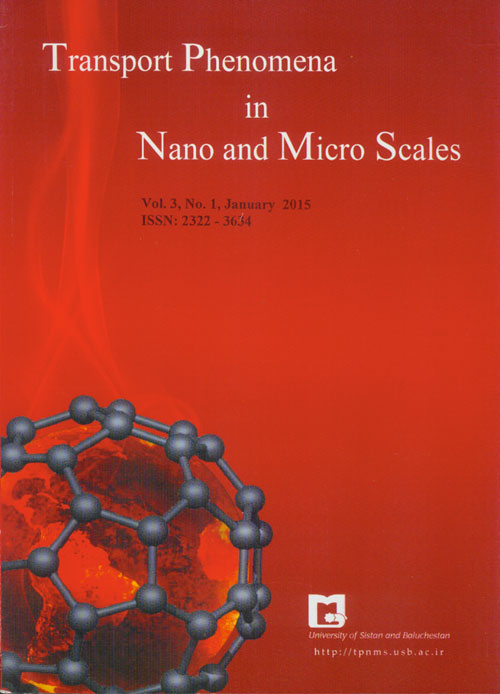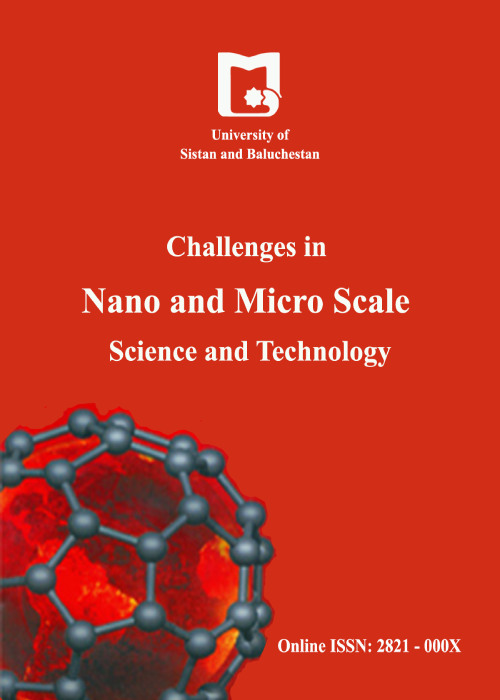فهرست مطالب

Journal of Transport Phenomena in Nano and Micro Scales
Volume:3 Issue: 1, Winter - Spring 2015
- تاریخ انتشار: 1393/11/12
- تعداد عناوین: 7
-
-
Pages 1-13This paper was aimed to address the modeling of effective thermal conductivity and viscosity of carbon structured nanofluids. Response surface methodology, D_optimal design (DOD) was employed to assess the main and interactive effects of temperature (T) and weight percentage (wt %) to model effective thermal conductivity and viscosity of multi wall and single wall carbon nanotube, CVD and RGO Graphene and nanoporous Graphene sheet. The second-order polynomial regression model was proposed for effective thermal conductivity and viscosity as a function of relevant investigated parameters. Effective thermal conductivity and viscosity of nanofluids measured using an accurate transient short hot wire system and a viscometer, respectively. nanofluids was prepared using two-step method and showed a desirable stability. In general, Graphene nanosheets have more effective thermal conductivity and viscosity compared to carbon nanotube because of variation in shape and likely size.Keywords: modeling, carbon structured nanofluid, Response surface methodology, effective thermal conductivity, viscosity
-
Pages 14-28Micro scale gas flows has attracted significant research interest in the last two decades. In this research, the fluid flow of gases in the stepped micro-channel at a wide range of Knudsen number has been analyzed with using the Lattice Boltzmann (MRT) method. In the model, a modified second-order slip boundary condition and a Bosanquet-type effective viscosity are used to consider the velocity slip at the boundaries and to cover the slip and transition regimes of flow and to gain an accurate simulation of rarefied gases. It includes the slip and transition regimes of flow. The flow specifications such as pressure loss, velocity profile, streamline and friction coefficient at different conditions have been presented. The results show good agreement with available experimental data. The calculation shows that the friction coefficient decreases with increasing the Knudsen number and stepping the micro-channel has an inverse effect on the friction coefficient. Furthermore, a new correlation is suggested for calculation of the friction coefficient in the stepped micro-channel as below; C_f Re = 3.113+2.915/(1 +2 Kn)+ 0.641 exp(3.203/(1 + 2 Kn))Keywords: Micro, channel, Lattice Boltzmann, Friction Coefficient, Knudsen Number, Gas Flow
-
Pages 29-36
Forward osmosis (FO) has recently drawn attention as a promising membrane based method for seawater and brackish water desalination. In this study, we focus on the use of calciun chloride (CaCl2) and potassium bicarbonate (KHCO3) as inorganic salt draw solution candidates due to their appropriate performance in water flux and reverse salt diffusion as well as reasonable cost. The experiments were carried at 25 °C and cross-flow rate of 3 L min−1. At the same osmotic pressure, the water flux of CaCl2 draw solution tested against deionized feed water, showed 20% higher permeation than KHCO3, which it was attributed to the lower internal concentration polarization (ICP). The reverse diffusion of CaCl2 was found higher than KHCO3 solution which it would be related to the smaller ionic size and the higher permeation of this salt through the membrane. The water flux for both draw solutions against 0.33 M NaCl feed solution was about 2.8 times lower than deionized feed water because of ICP. Higher concentrations of draw solution is required for increasing the water permeation from saline water feed towards the draw side.
Keywords: Forward osmosis, Inorganic draw solution, Potassium bicarbonate, Calcium chloride -
Pages 37-45Natural convection heat transfer has many applications in different fields of industry; such as cooling industries, electronic transformer devices and ventilation equipment; due to simple process, economic advantage, low noise and renewed retrieval. Recently, heat transfer of nanofluids have been considered because of higher thermal conductivity coefficient compared with those of ordinary fluids. In this study; natural convection and entropy generation in a triangular enclosure filled by Al2O3 –water nanofluid affected by magnetic field considering Brownian motion is investigated numerically. Two inclined walls are maintained at constant cold temperature (Tc) while the bottom wall is kept at constant high temperature (Th) with (Th>Tc). In order to investigate natural convection, a computer program (FORTRAN language) based on finite volume method and SIMPLER algorithm has been used. Analyses is performed for volume fraction of nanoparticles 0, 0.02, 0.04, Hartmann number 0, 50,100, Rayleigh numbers 103,104,105 and angle of inclined walls 450. In investigated angles and Rayleigh numbers; average Nusselt number is increased by enhancement of volume fraction of nanoparticles in a fixed Hartmann number. It is also observed that total entropy generation variations by increasing volume fraction of nanoparticles is similar to that of Nusselt number. By the results; effect of friction is always insignificant on generated entropy. It is observed that natural convection of nanofluid is decreased by enhancement of Hartmann number and its behavior is close to thermal conduction. It is also concluded that average Nusselt number and total generated entropy are decreased.Keywords: Nanofluid, Hartman number, entropy generation, triangular enclosure, Bejan number, Brownian motion
-
Pages 46-53The main objective of this paper is to examine the effect of nanomaterials on mass transfer coefficient in bubble type absorption of carbon dioxide by experiment. The absorption process is carried out in a bubble column and in room temperature. Mass transfer coefficient, saturated concentration of CO2, and gas holdup are determined in this system. The kinds of nanomaterials, the concentrations of each one and the gas superficial velocity are considered as the key parameters. The results show that the mass fraction of nanomaterials has an optimum value to the mass transfer coefficient and saturated concentration of CO2. 0.07% CNT nanofluid increases the mass transfer coefficient up to 78%. The superficial velocity of CO2 enhances mass transfer coefficient and gas holdup within the experimental range, whilst it has no effect on saturated concentration of CO2. In addition, nanomaterials in solution increase the gas holdup.Keywords: Nanofluid, gas absorption, nanostructure materials, mass transfer coefficient, gas holdup
-
Pages 54-61Nanofluid is a new class of heat transfer fluids engineered by dispersing metallic or non-metallic nanoparticles with a typical size of less than 100 nm in the conventional heat transfer fluids.This article aims to investigate the overall and convection heat transfer coefficient and Nusselt number of Al2O3-water nanofluid flowing in a horizontal double pipe heat exchanger under turbulent flow () conditions. Al2O3 nanoparticles with diameter of 20 nm dispersed in Deionized water with volume concentrations of vol. are used as the test fluid. The results show that the overall and convection heat transfer coefficient and Nusselt number of nanofluid were approximately 15% -21% greater than that of pure fluid. Additionally, the heat transfer coefficient and Nusselt number increase with an increase in flow rate,Reynolds number, nanoparticle concentration and nanofluid temperature. Finally, the new correlations were proposed for predicting the Nusselt number of the nanofluids, especially. Employing particles of nanometer dimension suspended in solution as nanofluid shows considerable increase in the nanofluid thermal conductivity and heat transfer coefficient which result in increasing heat transfer and decreasing operational cost.Keywords: Nanofluid, Heat exchanger, Nusselt number, heat transfer coefficient
-
Pages 62-67A simple chemical vapor deposition technique at atmospheric pressure (APCVD) is adopted to synthesize the aligned arrays of functionalized multi-walled carbon nanotubes (AMWCNTs) without using any carrier gas, at 230◦C, 750◦C and 850 ◦C. Camphor (C10H16O) is used as carbon source because this botanical hydrocarbon is chip and abundant which convert the CVD technique to a green method for production of carbon nanotubes (CNTs). The oxygen atoms in camphor oxidize the amorphous carbons and create hydroxyl functional groups in AMWCNTs. The molecular structure of camphor lead to form hexagonal and pentagonal carbon rings which increase the growth rate and alignment of MWCNTs. In this work, AMWCNTs are grown on silicon substrate, copper, and quartz. The synthesized AMWCNTs are characterized by scanning electron microscopy (SEM), Fourier transform infrared (FTIR) and transmission electron microscopy (TEM). The SEM results show that the deposited CNTs are formed in vertical aligned arrays and each has a functional OH group which is seen in FTIR spectroscopy results.Keywords: carbon nanotube, camphor, atmospheric pressure chemical vapor deposition, aligned arrays, multi, wall


